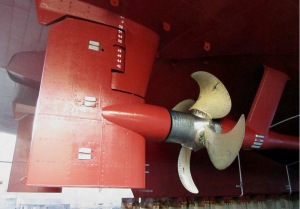A ship’s propeller is an important moving part whose efficiency determines its speed and meeting of deadlines and maintenance of schedules. Whether its by flawed design or by over-use, propellers suffer from certain problems which affect the marine operations negatively.
Firstly, the common propeller problems should be mentioned since knowing more about them is essential for the perspective of solutions.
- Propeller-induced vibration, the first problem is caused by in-accuracy in pitch, camber and section shapes.
- Abrasives present in surrounding spaces cause tip erosion; reducing overall diameter and performance of the propeller.
- Cavitation causes vibration, noises and serious damage to the propeller; Propeller-induced cavitation and vessel-induced cavitation induced by appendages, hull shape and application.
- Propeller-induced engine overload; most common on yachts where the first sign is black smoke from transom.
- Occasionally, engines rev higher than the recommended maximum RPM thus not accumulating maximum horsepower.
- Propellers are sometimes not synchronised, an issue common on twin-screw vessels, caused by pitch, camber and section shape differences between 2 propellers.
- Excessive fuel consumption due to poor propeller performance.
- Poor selection of propeller type, category or other parameters.
Knowing the above problems, its also essential to consider the most popular type of propeller used in naval builds; the screw propellers; enabling ships to move faster and with time enhance their durability. However, this kind of propeller, alongside issues mentioned above the propeller vibration is caused by its wake pattern; responsible for loss. Wake is mostly a region of fluid flowing around a moving body and their impacts can be controlled by ducts (Mewis duct, Scheenkluth duct) fitted on the hull or before the propeller.
Another method can be fitting of a Simplified Compensative Nozzle which reduces oscillation at the inflow and reducing noise levels. One more variable is cavitation/formation of vapour bubbles on suction side of the propeller where cavity forms as pressure from water around it falls below the water pressure level. These bubbles are carried to the surfaces, imploding on it and causing propeller blades to wear faster. However, cavitation can be useful in reducing friction; present in specially-designed propellers. Cavitation itself is a transition of fluid into vapour due to local reduction of pressure which itself is generated by high local flow velocities and increased by water temperature. This issue can be avoided by constructing the propeller itself from stainless steel as the alloy metal is resistant to oxidation as well as being impermeable to water and air. Stainless steel is also a material that has a protective layer of chromium oxide which rapidly reforms and protects the part itself; supporting addition of other elements to better suite operations.
Leading back to the maintenance aspect, the first thing to consider when considering ship management is to have a spare propeller on-hand to replace a malfunctioning one. It is also important to keep the shaft greased (waterproof grease 2-4-C) and painting propellers themselves. Painting individual parts helps prevent corrosion and oxidation, however parts such as propellers and stern gear should never be painted with standard anti-fouling since it increases chance of electrolysis on the painted parts.
Talking about electrolysis, an anode electrode must be fitted on the vessel in order to reducing the risk of the propeller contracting electrolysis. However, checking the common types of water the boat operates in; salt water=zinc anodes, fresh water=magnesium anodes.
Finally, propellers also come in different types; the SOLAS Alcup and stainless steel propellers where special approaches to be considered. SOLAS Alcup propellers should have torsion rods greased in the hub while stainless steel can be protected with corrosion guard.


